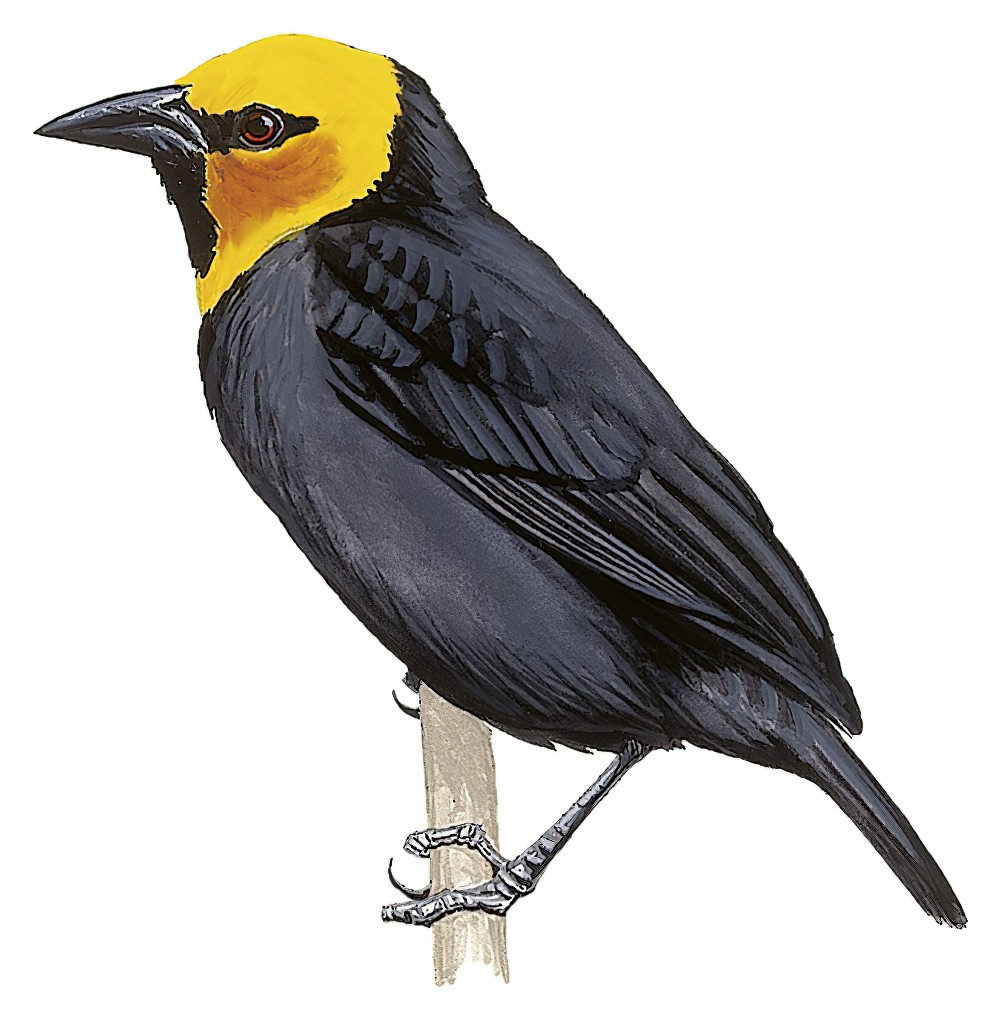Black-billed Weaver / Ploceus melanogaster

Black-billed Weaver
SCI Name:
Protonym: Ploceus melanogaster Proc.Zool.Soc.London Pt1 p.126
Taxonomy: Passeriformes / Ploceidae / Ploceus
Taxonomy Code: blbwea1
Type Locality: Cameroon Mt., 8,000 ft.
Author: Shelley
Publish Year: 1887
IUCN Status: Least Concern
DEFINITIONS
PLOCEUS
(Ploceidae; Ϯ Baya Weaver P. philippinus) Gr. πλοκευς plokeus weaver < πλεκω plekō to plait, to entwine; "LES TISSERINS. (PLOCEUS. Cuv.) (2). A bec assez grand pour les avoir fait en partie classer parmi les cassiques; mais sa commissure droite les en distingue. Ils ont de plus la mandibule supérieure légèrement bombée. On en trouve dans les deux continens. La plupart de ceux de l'ancien font leur nid avec beaucoup d'art, en entrelaçant des brins d'herbes, ce qui les a fait nommer TISSERINS. Tel est le Toucnam-Courvi des Philippines. (Loxia Philippina. Lin.) Enl. 135. Jaune tacheté de brun, à gorge noire. Son nid, suspendu, est en forme de boule, avec un canal vertical, et ouvert en dessous, qui communique par le côté dans la cavité où sont les petits (1). Quelques-uns rapprochent leurs nids en grande quantité, pour en former un seule masse à plusieurs compartimens. Tel est le Républicain. (Loxia socia. Lath.) Paterson. Voy. pl. 19. ... (2) Πλοκευς, tisserand. ... (1) Ajoutez le capmore, Buff. (Oriolus textor, Gm.), enl. 375 et 376. — Fringilla erythrocephala, enl. 665. — Le prétendu tangara de malimbe, Daud. An. Mus. I, p. 148, pl. x. — Le baglafecht. (Lox. Abyssinica.) — Le nélicourvi (lox. pensilis), Sonn., 2e Voy. pl. 109." (Cuvier 1817); "Ploceus Cuvier, 1817, Règne Anim., 1, p. 383. Type, by subsequent designation, Loxia philippina Linnaeus (Gray, 1840, List Gen. Birds, p. 42)." (Moreau in Peters 1962, XV, 32). Recent work indicates that the African and Malagasy members of this genus should be included in Malimbus.
Var. Ploceys.
Synon. Bensonhyphantes, Cinnamopteryx, Deignaniplectes, Deleplectes, Dendrhyphantes, Eremiphantes, Eremiplectes, Euploceus, Eupodes, Heterhyphantes, Hypermegethes, Hyphantornis, Hyphanturgus, Hypositagra, Icteropsis, Melanhyphantes, Melanoploceus, Melanopteryx, Microplectes, Microploceus, Nelicurvius, Notiospiza, Oriolinops, Oriolinus, Othyphantes, Pachyphantes, Phormoplectes, Plesiositagra, Ploceella, Ploceolus, Rhinoploceus, Saka, Sharpia, Sitagra, Sitagroides, Sycobrotus, Symplectes, Textor, Thomasophantes, Xanthophilus, Xanthoplectes, Xanthoploceus.
melanogaster / melanogastra / melanogastris / melanogastrus
Gr. μελας melas, μελανος melanos black; γαστηρ gastēr, γαστρος gastros belly.
● ex “Black-bellied Grosbeak” of Latham 1783 (syn. Euplectes afer).
SUBSPECIES
Black-billed Weaver (Western)
SCI Name: Ploceus melanogaster melanogaster
melanogaster / melanogastra / melanogastris / melanogastrus
Gr. μελας melas, μελανος melanos black; γαστηρ gastēr, γαστρος gastros belly.
● ex “Black-bellied Grosbeak” of Latham 1783 (syn. Euplectes afer).
Black-billed Weaver (Eastern)
SCI Name: Ploceus melanogaster stephanophorus
STEPHANOPHORUS
(Thraupidae; Ϯ Diademed Tanager S. diadematus) Gr. στεφανος stephanos diadem, crown < στεφανοω stephanoō to crown; -φορος -phoros -carrying < φερω pherō to carry; "Genus STEPHANOPHORUS †, n.g. < Tanagra, Tem., < Pyrrhula, Vieill. Diff. Char.—Beak very short, tumid, of equal height and length. Rostrum breve, subconicum, mandibulis subæqualibus, intumidis; culmine gradatim deorsum, gonyde sursum incurvatis; commissura subrecta, leviter deorsum curvata; maxilla juxta apicem obsoletissime emarginata. Nares subrotundæ. Alæ mediocres, rotundatæ, remigibus 3a, 4a (hac longissima) et 5ta fere æqualibus. Cauda mediocris, rectricibus subæqualibus. Pedes mediocres, acrotarsiis scutellatis, paratarsiis integris, Digitus externus interiorem paulo excedens. Ungues mediocres, leviter curvati. Ptilosis cærulescens, nitore sericeo. Vertex colore igneo insignis. Habitat in America meridionali. Species unica, S. cœruleus (Vieill.), (T. diadema, Temm.), Pl. Col. 243. Obs. The beak is more tumid and the under mandible more developed in this well-marked type than in any other of the Tanagrinæ, and it has hence been referred to the genus Pyrrhula. The marginal notch, however, together with the blue and silky plumage, and the geographical distribution, sufficiently prove the true place of this bird to be among the Tanagers, and in the vicinity of Tanagra, Lin. (restr.), and Calospiza Gray (Aglaia, Sw.). ... † Στεφανος, a crown; φερω, to bear." (Strickland 1841); "Stephanophorus Strickland, 1841, Proc. Zool. Soc. London, 9, p. 30. Type, by monotypy, Pyrrhula coerulea Vieillot = Tanagra diademata Temminck." (Storer in Peters 1970, XIII, 336).
Synon. Bergia.
UPPERCASE: current genus
Uppercase first letter: generic synonym
● and ● See: generic homonyms
lowercase: species and subspecies
●: early names, variants, mispellings
‡: extinct
†: type species
Gr.: ancient Greek
L.: Latin
<: derived from
syn: synonym of
/: separates historical and modern geographic names
ex: based on
TL: type locality
OD: original diagnosis (genus) or original description (species)












